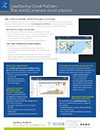Challenges Upgrading to P6R8 – and Why It’s Worth It
If you’re already an Oracle Primavera user for project portfolio management, upgrading to P6R8 from Release 7 or earlier may simply be a case of getting the most out of the incremental new functionality. But suppose your organization has been using a mixed bag of different tools, Excel spreadsheets or other, for its PPM. An upgrade to P6R8 could be the chance to harmonize and streamline all project portfolio management. In that case, you may also face a few additional challenges.
What’s the Attraction of P6R8?
In addressing PPM needs across the enterprise, P6R8 lets users link multiple schedules together easily using multiple baselines. It also unifies resource capacity planning and gives a complete view of the whole company project portfolio. From Release 8.2 onwards, you can update an existing P6 project using an XML file from Microsoft Project. That way if diehards insist on using Microsoft Project, there’s still room for them in the enterprise PPM universe. And the prospect of also moving from disparate Excel files to one global, robust P6 solution is likely to bring a smile to many a project or program manager’s face.
Technical Considerations
A P6R8 solution requires certain computing platform resources. Depending on which modules you want to use, an application server for Citrix (for the P6 client application), a web server and a reporting server may be necessary, as well as one or more SQL servers. A hosting provider specialized in cloud-based PPM can look after all the hardware and platform software needed. Hosted solutions can also include access to auxiliary services such as Team Member (mobile working) and Business Intelligence Publisher for report generation and distribution. A good hosting provider will ensure that the versions of the different system components are all compatible, and offer one universal point of contact for queries on any of the modules being used.
End-User Buy-In and Training
Moving to a new system means change, wherever you’re starting from. Advanced warning, or rather, motivating information sessions can help by showing users the new functionality and the good reasons for moving to P6R8. It’s important to differentiate between functionality in the web user interface that is not available in the client application, and to ensure users’ browsers are of the correct version and properly configured. Examples include enabling pop-ups and disabling Java automatic updates to avoid any moves to unsupported versions of Java.
Administrator Responsibilities
Administrators need training too. Even if you use a hosted solution, your enterprise may need to migrate databases and archive old data as historical records. A sound plan is required for switching legacy databases to read-only mode before permanently retiring them. Other projects may need to be transferred to a new database from the various tools currently in use. Best-in-class hosting providers will offer supporting consultancy services to help you accelerate such processes, while bringing your administrators up to speed at the same time. While there may be ‘no gain without pain’, knowing in advance how best to reap the benefits of a P6R8 upgrade may help you save on aspirin!
Two cloud systems are continuing to gain popularity for using P6R8 on the fly—our very own SpringBoard™ 7.0 portal and LoadSpringMobile. – See more about how you can upgrade to P6R8 and have it in the cloud: http://www.loadspring.com/solutions/











